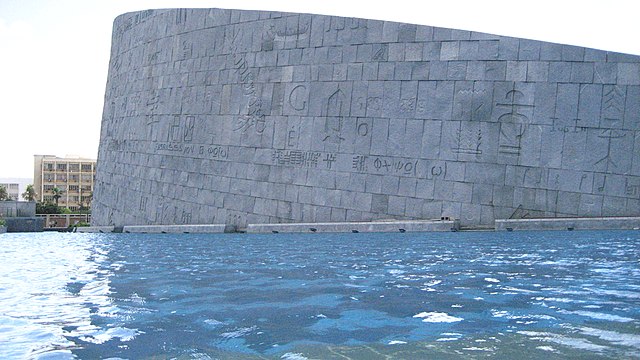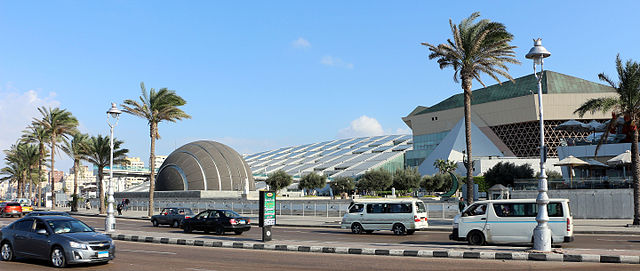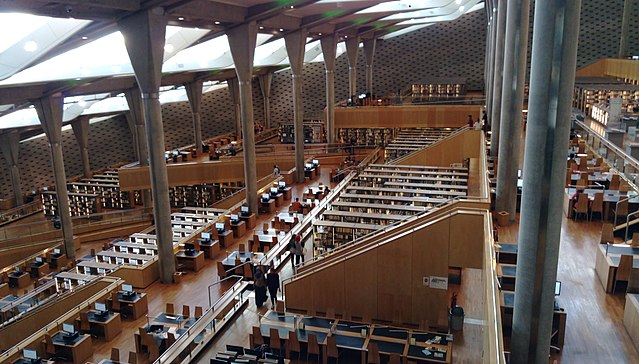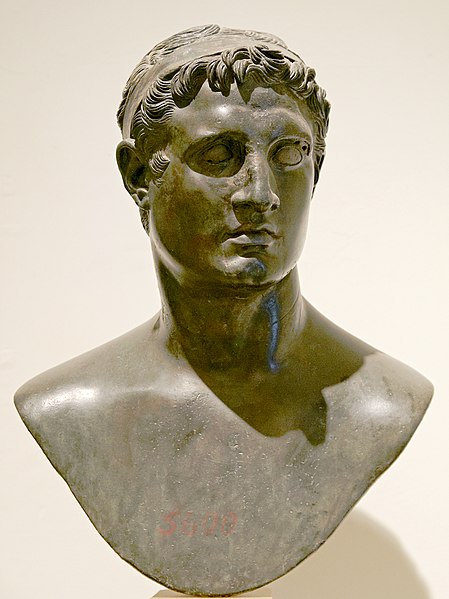The Bibliotheca Alexandrina (BA) is a major library and cultural center on the shore of the Mediterranean Sea in Alexandria, Egypt. It is a commemoration of the Library of Alexandria, once one of the largest libraries worldwide, which was lost in antiquity. The idea of reviving the old library dates back to 1974 when a committee set up by Alexandria University selected a plot of land for its new library. Construction work began in 1995, and after some US$220 million had been spent, the complex was officially inaugurated on 16 October 2002. In 2009, the library received a donation of 500,000 books from the Bibliothèque nationale de France (BnF). The gift makes the Bibliotheca Alexandrina the sixth-largest Francophone library in the world.
Bibliotheca Alexandrina
Bibliotheca Alexandrina
Mediterranean Sea side / northern exterior of the modernistic architecture of the Biblioteca Alessandrina Library, in Alexandria, Egypt. (photo: October 2020)
Inside the Bibliotheca Alexandrina, built during the 1990s on the Mediterranean Sea coastline, near the harbor of Alexandria, Egypt, opened October 2002.
The Great Library of Alexandria in Alexandria, Egypt, was one of the largest and most significant libraries of the ancient world. The library was part of a larger research institution called the Mouseion, which was dedicated to the Muses, the nine goddesses of the arts. The idea of a universal library in Alexandria may have been proposed by Demetrius of Phalerum, an exiled Athenian statesman living in Alexandria, to Ptolemy I Soter, who may have established plans for the Library, but the Library itself was probably not built until the reign of his son Ptolemy II Philadelphus. The Library quickly acquired many papyrus scrolls, owing largely to the Ptolemaic kings' aggressive and well-funded policies for procuring texts. It is unknown precisely how many scrolls were housed at any given time, but estimates range from 40,000 to 400,000 at its height.

Nineteenth-century artistic rendering of the Library of Alexandria by the German artist O. Von Corven, based partially on the archaeological evidence available at that time
A Hellenistic bust depicting Ptolemy I Soter, 3rd century BC, the Louvre, Paris
A Roman copy of an original 3rd century BC Greek bust depicting Alexander the Great, Ny Carlsberg Glyptotek, Copenhagen
Bust excavated at the Villa of the Papyri depicting Ptolemy II Philadelphus, who is believed to have been the one to establish the Library as an actual institution, although plans for it may have been developed by his father Ptolemy I Soter








